1839 Contemporary Art Gallery (1839當代藝廊) is an easy art space to miss. Located down a side-street in Taipei’s Daan District (大安) the gallery doesn’t exactly scream “come in.” But the discreet facade and somewhat pedestrian setting of 1839 deflects those who are not seeking out the Aladdin’s Cave of photobooks and photographic artwork housed just below street level.
The subterranean gallery’s name alludes to the year when Frenchman Louis Daguerre unveiled the daguerreotype process, a pioneering step in the evolution of photography. In keeping with this spirit, 1839 has made a name for itself as a space that showcases cutting edge photography –– visual art with the power to pose pertinent questions about contemporary life.
Engram (印物累季), which is currently on display, does just that.
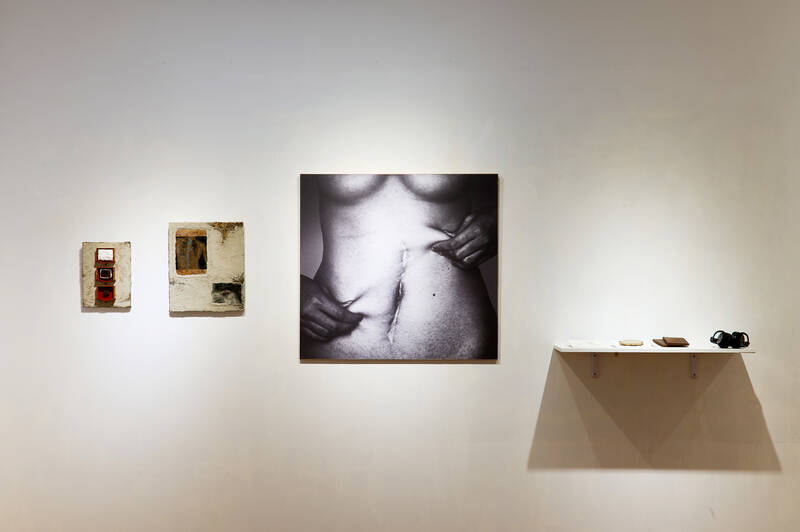
Photo Courtesy Yang Chia-shin
Curated by Ma Li-chun (馬立群), the 60 artworks festooning all walls of the gallery represent a culmination of four-years’ work by one up-and-coming creative talent, Yang Chia-shin (楊佳馨).
Employing various forms of media, ranging from medical radiographs to video installation and hand-crafted photobooks, Engram explicitly communicates “the illnesses, trauma and injuries” Yang has experienced to gallery visitors with diary-like candidness.
The Chaos Abyss, for example, is a series of images created by the artist in the wake of a serious road accident in 2022. Initially, Yang used her broken mobile phone to document the crash resulting in “damaged, blurred and shaken images” that expressed her mental state from the moment of the accident through to the recovery period. At the rear of the gallery there’s even a motorcycle seat placed before a video showing footage of the car accident, so that visitors can get a feel for the crash. An image titled Titanium (鈦) is actually the X-ray of Yang’s clavicle bone screwed to metal plate, expressing both “fracture and rebirth.”
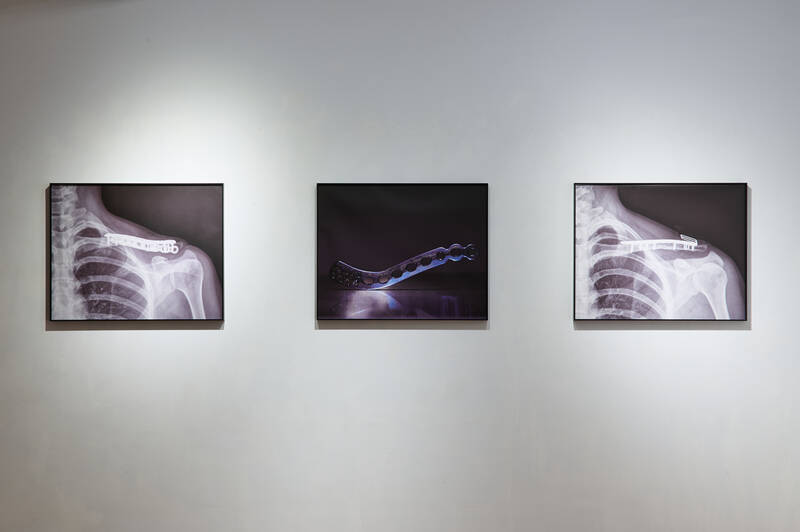
Photo Courtesy Yang Chia-shin
Indeed, it is Yang’s “disease history,” explored from all angles, that is her autobiographical motif. Presented in three parts, Visual and Mental State, Reality and Fiction in Illness Memory and Exploration of Body Sense and Materiality, the artworks on show wire the artist’s inner world to the external, provoking gallery visitors to meditate on questions pertaining to life’s fragility and the blurred relationship between the external presentation of the social self and inner-workings of the human hidden beneath the skin.
Notwithstanding the dark and reflective subject matter manifest in a self-portrait of her scarred abdomen (Imprint I, 印記 I), the 25-year-old proves charming and vivacious as she answers audience questions and participates in lively debate between curators and critics during the opening ceremony, which was held on April 27.
Afterwards, Yang sat down with Taipei Times to discuss her creative journey.
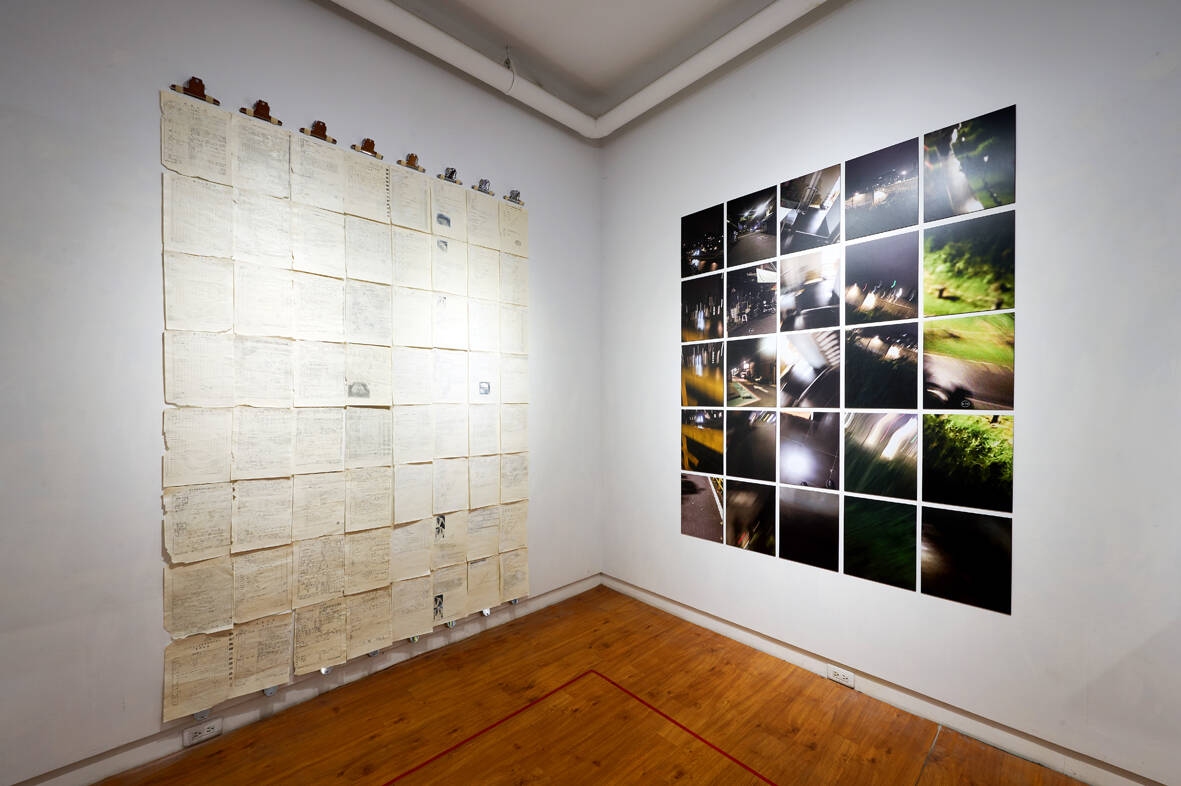
Photo Courtesy Yang Chia-shin
GRAPHIC ART
“My mother was a music teacher so there was always an artistic atmosphere in the house,” Yang recalls of her early life growing up in Tainan. Despite regular bouts of illness, Yang has found memories of her childhood in southern Taiwan, where she says “the food is better,” the “weather is warm” and she was always encouraged to follow her passions.
Her creative talents surfaced while at high school when she discovered an aptitude for art.
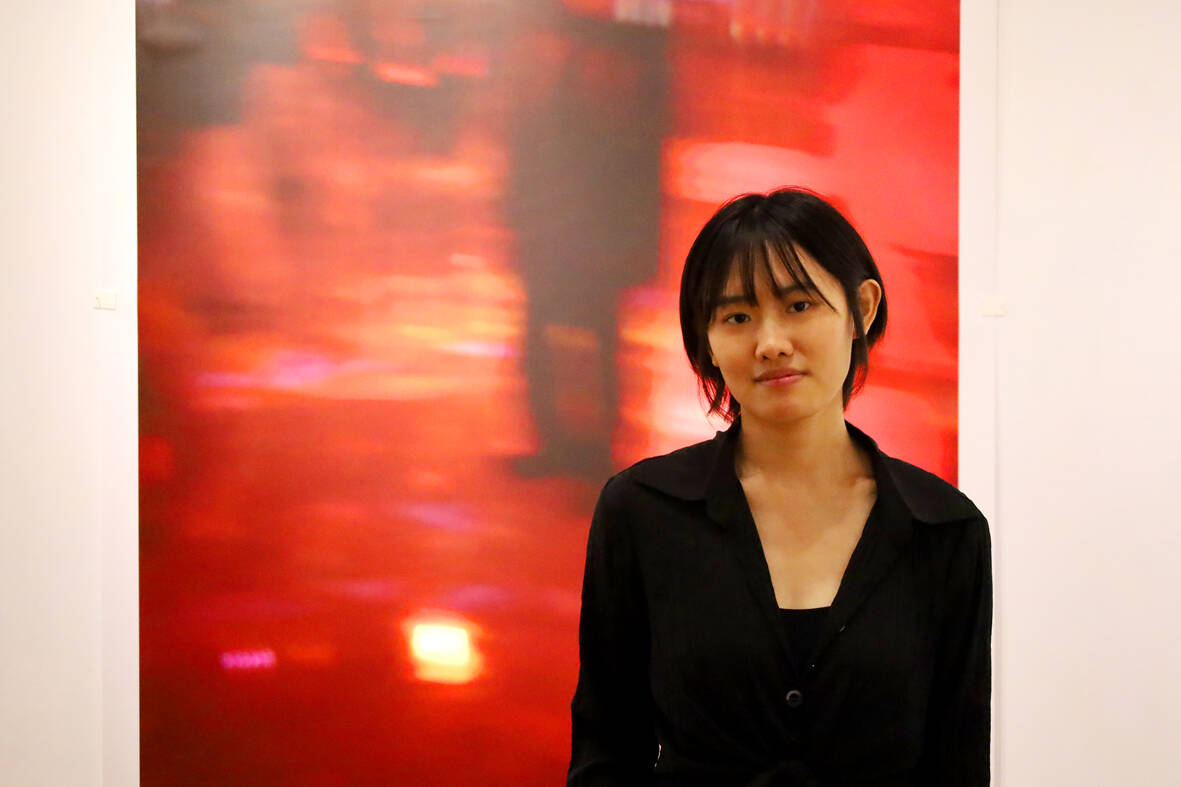
Photo: Thomas Bird, Taipei Times
“There was a class in advertisement design I was good at,” she says. “That’s where I learned how to draw.”
Yang got hold of her first camera around this time as well.
“I remember, it was a Canon 760D,” she says, “and it went with me everywhere. I took pictures of everything, people and landscapes. That’s all I wanted to do.”
Yang’s talents won her a coveted place at Shih Hsin University (世新大學) in Taipei, where she studied photography, graphic design and publishing.
It was during her freshman year that she had the epiphany to make her art practice a self-expletory act, “turning the camera around” as she puts it, in order to explore the internal world and her invisible struggles.
“A recurrence of irritable bowel syndrome in 2019 made me want to vent my dissatisfaction with my situation, so I started to carve dates onto palm-sized concrete blocks until there was no more space,” she says, as if her illness was akin to doing time in a prison cell.
This work became Imprint IV (印記IV).
“After that, I began to graft my own experiences of illness onto everything I did.”
She refers me to a work titled Imprint II (印記II), which is currently on display.
“You can see it looks like a train track, right? That is because my mother used to comfort me by saying my scars look like a railway, so I wouldn’t feel so self-conscious.”
As we talk, it grows evident Imprint II also symbolizes Yang’s soaring imagination, as she puts it, “a desire to explore the unknown, to leave the physical body and travel.”
TURNING PAIN INTO PICTURES
“After I published the book So What? in 2023, the owner of the 1839 Contemporary Art Gallery Chiu I-chien (邱以健), who I’d known for some time, approached me and asked if I might like to have a solo exhibition at his space,” Yang says.
The phone-sized book that won Yang this opportunity is actually a photo album in which the pages can be opened and folded in different ways “to reflect on the state of life through a paper exhibition,” she says.
In many ways, Engram is a broader realization of the So What? photobook –– asserting that life can be read from different perspectives; where truth is often obscured and one’s journey can change direction suddenly. This is arguably Yang’s power: Although her work is superficially about the self, the themes she explores are universal, even if they are, conversely, taboo.
Transforming her suffering into art is doubtlessly courageous but I wonder if it has come at a cost. How does her family feel of her exhibiting her medical records or intimate pictures from the hospital ward –– things that tend to be private –– in the public domain?
“They’re mostly supportive of me, although I am a bit worried what they’ll say when they see the exhibition,” Yang says, laughing.
But of Engram’s core message, she remains characteristically bold and uninhibited: “This is an exhibition colored by different shades of pain. But by meshing my own experiences with various materials and media, I do hope to share my desire for life, my hope, as well as communicating my knowledge of death.”
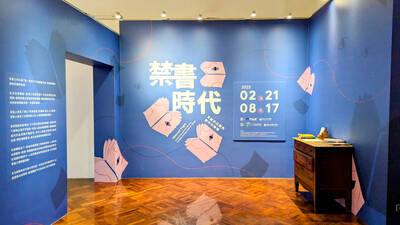
From censoring “poisonous books” to banning “poisonous languages,” the Chinese Nationalist Party (KMT) tried hard to stamp out anything that might conflict with its agenda during its almost 40 years of martial law. To mark 228 Peace Memorial Day, which commemorates the anti-government uprising in 1947, which was violently suppressed, I visited two exhibitions detailing censorship in Taiwan: “Silenced Pages” (禁書時代) at the National 228 Memorial Museum and “Mandarin Monopoly?!” (請說國語) at the National Human Rights Museum. In both cases, the authorities framed their targets as “evils that would threaten social mores, national stability and their anti-communist cause, justifying their actions

Taiwanese chip-making giant Taiwan Semiconductor Manufacturing Co (TSMC) plans to invest a whopping US$100 billion in the US, after US President Donald Trump threatened to slap tariffs on overseas-made chips. TSMC is the world’s biggest maker of the critical technology that has become the lifeblood of the global economy. This week’s announcement takes the total amount TSMC has pledged to invest in the US to US$165 billion, which the company says is the “largest single foreign direct investment in US history.” It follows Trump’s accusations that Taiwan stole the US chip industry and his threats to impose tariffs of up to 100 percent

In the run-up to World War II, Admiral Wilhelm Canaris, head of Abwehr, Nazi Germany’s military intelligence service, began to fear that Hitler would launch a war Germany could not win. Deeply disappointed by the sell-out of the Munich Agreement in 1938, Canaris conducted several clandestine operations that were aimed at getting the UK to wake up, invest in defense and actively support the nations Hitler planned to invade. For example, the “Dutch war scare” of January 1939 saw fake intelligence leaked to the British that suggested that Germany was planning to invade the Netherlands in February and acquire airfields

The launch of DeepSeek-R1 AI by Hangzhou-based High-Flyer and subsequent impact reveals a lot about the state of the People’s Republic of China (PRC) today, both good and bad. It touches on the state of Chinese technology, innovation, intellectual property theft, sanctions busting smuggling, propaganda, geopolitics and as with everything in China, the power politics of the Chinese Communist Party (CCP). PLEASING XI JINPING DeepSeek’s creation is almost certainly no accident. In 2015 CCP Secretary General Xi Jinping (習近平) launched his Made in China 2025 program intended to move China away from low-end manufacturing into an innovative technological powerhouse, with Artificial Intelligence